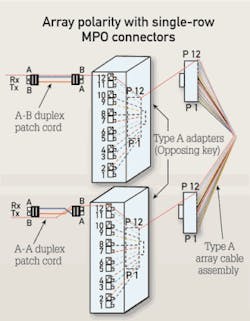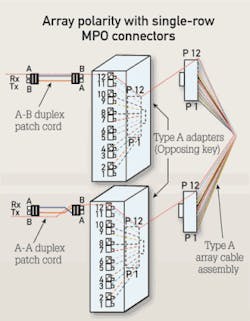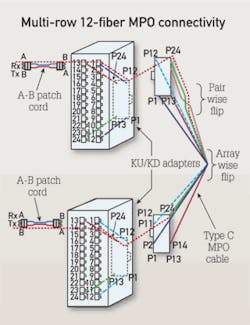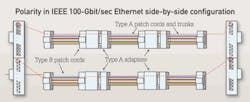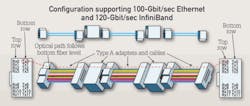Maintaining fiber-optic polarity with array cabling
Parallel fiber-optic links present options, and require planning, for fiber-polarity maintenance.
by Sharon Lutz, US Conec
The use of preterminated fiber assemblies and cassettes is growing, and the deployment of systems with speeds up to and beyond 100 Gbits/sec are on the horizon for many users. As a result, the issue of maintaining polarity in parallel fiber-optic links is becoming increasingly important. Described simply, polarity maintains proper continuity between transmitters and receivers. Currently users do not have "absolute musts" in the form of cabling standards to dictate how they achieve fiber polarity, and several options exist for doing so. This article discusses the emerging applications that are pushing the topic of polarity to users' front-of-mind, and focuses on the options available to maintain polarity.
Polarity in point-to-point duplex links is a simple concept. Typically it is achieved through what is known as an A-to-B patch cord. However, as users move beyond point-to-point links some complications come into play. These more-complicated links may have a duplex or parallel connection on each end, but in between those connections may be any type of structured cabling plant that includes duplex cables, array cables, adapters and/or transition modules that must be managed.The setup illustrated here is specified in TIA-568-C.0 as Method A for maintaining array polarity with single-row MPO connectors.
Today multiple applications use array connectivity in the cable plant. Duplex configurations include SFP, SFP+, XFP, SFF and XENPAK. These duplex connections have simple, consistent transmit-and-receive configurations and they employ A-to-A cable and/or A-to-B patch cords in combination with breakout sets to array adapter types and multiple array trunk configurations.
Parallel configurations include QSFP, 120-Gbit/sec Fibre Channel and 100-Gbit/sec Ethernet. These configurations employ various combinations of single-row and/or multi-row array cable types in combination with two array adapter types.
Array connectors and polarity
The MPO-style (multifiber push-on) connector is now being widely adopted in parallel-optics configurations to achieve extremely high data-transmission rates, such as 100-Gbit/sec Ethernet and other protocols. MPO connectors have been used in duplex fiber-optic links for some time as well. Maintaining polarity within 12- and 24-fiber MPO connectors can be challenging, and will be the focus of the remainder of this article.
There are several four-lane variants of parallel configurations, meaning that within a 12-fiber connector, four fibers are designated transmit and four other fibers designated receive. For applications such as QSFP, InfiniBand 4X, Fibre Channel, OIF VSR4-03 and IEEE 802.3ba 40-Gbit/sec Ethernet, when the 12-fiber MPO connector is in the key-up position, the four fibers on the left side are transmit and the four fibers on the right side are receive. The IEEE specification does not include lane assignments for the four transmit and four receive fibers; specifications for the others do include lane assignments for each of the eight fibers in use. For example, with QSFP the four transmit fibers are numbered, from left to right, one through four. The four receive fibers are numbered, from right to left, one through four. For InfiniBand 4X, OIF VSR4-03 and Fibre Channel, the four transmit fibers are numbered zero through three from left to right, and the four receive fibers are numbered zero through three right to left. For IEEE 802.3ba 40G, the four transmit fibers are simply designated transmit and the four receive fibers are designated receive.
Currently TIA-568-C.0 offers no guidance addressing polarity in multi-row, 24-fiber MPO connectivity. One potential method of maintaining polarity in such links is illustrated here. If this or another method described in this article is used on multi-row 24-fiber MPO connections, the user will have to re-label a cassette because the array-wise flip in the cable changes the fiber positions.
Some transmission protocols use 12-lane variants within the 12-fiber connector, and there is a little more variation among these than among the four-lane variants. For example, protocols including SNAP 12, OIF VSR4-01 and OIF VSR5-01 number the fibers 1 to 12 going right to left with the MPO connector key-up. These 12 fibers are transmit or receive. HIPPI-6400 uses two 12-fiber connectors, one for transmit and the other for receive. The transmit connector is numbered 12 to 1 left-to-right, key-up while the receive connector is numbered 1 to 12 left-to-right, key-up. InfiniBand 12X also uses two 12-fiber connectors, one for transmit and one for receive. In this scenario, fibers in the transmit connector are numbered 0 through 11 left-to-right, key-up while fibers in the receive connector are numbered 11 to 0 left-to-right, key-up.
With 100-Gbit Ethernet there are three possible options. The one we will describe as Option A is recommended within the 802.3ba specification. It is a 24-fiber connector with the center 10 lanes being used. With the connector oriented key-up, the top row is receive and the bottom row is transmit. Again, with the Ethernet specifications the 10 receive fibers and the 10 transmit fibers do not have specific lane assignments.
Option B for 100-Gbit Ethernet has side-by-side 12-fiber connectors, the center 10 lanes of each being used, with the connector on the left designated transmit and the connector on the right designated receive. Option C is vertically stacked, rather than side-by-side, 12-fiber connectors with the center 10 lanes of each being used, receive on top and transmit on the bottom.
Polarity with duplex links
The TIA-568-C.0 standard provides guidance on three possible methods of maintaining array polarity with single-row MPO connectors. Method A calls for an A-to-B duplex cord to be plugged into a Type A adapter. A Type A adapter is called opposing-key because it is oriented to make a key-up to key-down connection between the internal MPO connector and the MPO array cable connector. The Type A array cable assembly is also key-up to key-down in orientation, as it plugs into the two adapters. Finally, an A-to-A duplex cord completes the link.
Method B as described in TIA-568-C.0 uses Type B array cable and adapters, which are key-up to key-up in orientation. It also uses A-to-B patch cords. Method C uses Type C array cabling, which is oriented key-up to key-down and has pair-wise flips within the cable. Pair-wise flip means that adjacent pairs of fibers are crossed from one end of the cable to the other. So the fiber that is in position 1 at one end of the cable is moved to position 2 at the cable's other end, and vice versa. Method C also uses Type A adapters and A-to-B duplex patch cords.
Currently there is no guidance in TIA-568-C.0 addressing polarity in multi-row, 24-fiber MPO connectivity. Many configurations are possible, and the A, B and C single-row methods do not directly correlate to this type of configuration because of the complications associated with row-wise flips. The examples presented here are not standardized, but rather are some of many options available.
Potential Method A uses Type A array cables, Type A (key-up to key-down) adapters and duplex cords, A-to-A and A-to-B. Potential Method B has Type B array cables and adapters and A-to-B duplex patch cords. Potential Method C has an A-to-B patch cord on both ends, a Type C array cable Type A adapters.
One proposal put forth to support IEEE 100-Gbit Ethernet side-by-side connector configuration, illustrated here, uses Type A adapters, Type A 12-fiber trunks and Type A as well as Type B patch cords.
Using any of these methods will require you to re-label your cassette because the array-wise flip in the cable changes the positions of the fibers.
Polarity with parallel links
We'll move now to maintaining array polarity with parallel links. For single-row MPO, the 568-C.0 standard gives guidance on two possible methods, and a third method is currently under consideration as a possible addendum to the C.0 specification.
Method A, recognized in 568-C.0, uses Type A array cable with Type A adapters and Type A and B array patch cords. Method B, also recognized in 568-C.0 uses Type B throughout–Type B array cable, Type B adapters and Type B array patch cords.
The proposed Method C would use Type C array cable, which is key-up/key-down with a pair-wise flip, along with Type A adapters and Type C and Type B array patch cords.
Additionally, proposals have been put forth for TIA-568-C.0 to also support the IEEE 100-Gbit Ethernet side-by-side connector configuration. One proposed method for this configuration incorporates the use of existing 12-fiber trunks. It uses Type A adapters, Type A trunks and Type A as well as Type B patch cords.
The configuration illustrated here supports both the IEEE 100-Gbit/sec Ethernet and the InfiniBand 120-Gbit/sec applications.
Currently TIA-568-C.0 does not have any guidance on multi-row MPO configurations, however some configurations are being proposed to support IEEE 100-Gbit/sec Ethernet with existing 12-fiber trunks. A proposed Method A uses Type A adapters and trunks, as well as Type A and Type B hybrid patch cords–cords that have a 24-fiber connector on one end and two 12-fiber connectors on the other end.
A proposed Method B uses Type B 12-fiber MPO array cables, Type B adapters and two hybrid Type B patch cords. A proposed Method C uses two Type C 12-fiber MPO array cables, Type A adapters, one hybrid Type B patch cord and one hybrid Type C patch cord.
It is also possible to maintain multi-row polarity in systems using 24-fiber trunks and patch cords, such as 100-Gbit/sec Ethernet and 120-Gbit/sec InfiniBand. As stated earlier, the IEEE does not designate lane assignments for 100-Gbit Ethernet because it specifies a lane-striping protocol that sorts out the lanes at the receiver. For 120-Gbit/sec InfiniBand, the specification does give lane assignments. However, the lane-striping protocol used in the IEEE's 100-Gig specifications is optional in the 120-Gbit/sec InfiniBand specification.
A configuration that supports both 100-Gbit Ethernet and 120-Gbit Fibre Channel uses Type A adapters and cables. This setup maintains polarity as long as the transceivers on opposite ends of the links are flipped. In other words, set the transceiver upright on one side and upside down on the other side.
In conclusion, maintaining polarity through the use of array cables requires careful planning. Multiple cable types, fiber counts, row counts, adapter types and transceiver protocols add up to a significant number of options. The TIA has addressed single-row array cabling for duplex and parallel links. Also, multi-row transmit/receive polarity using single-row array trunk cabling is under consideration.
Sharon Lutz is applications engineer with US Conec (www.usconec.com). This article is based on information Lutz delivered in a webcast seminar in late 2010.
Past CIM Issues
